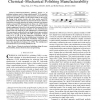Free Online Productivity Tools
i2Speak
i2Symbol
i2OCR
iTex2Img
iWeb2Print
iWeb2Shot
i2Type
iPdf2Split
iPdf2Merge
i2Bopomofo
i2Arabic
i2Style
i2Image
i2PDF
iLatex2Rtf
Sci2ools
89
Voted
DAC
2000
ACM
2000
ACM
Model-based dummy feature placement for oxide chemical-mechanical polishing manufacturability
—Chemical–mechanical polishing (CMP) is an enabling technique used in deep-submicrometer VLSI manufacturing to achieve long range oxide planarization. Post-CMP oxide topography is highly related to local pattern density in the layout. To change local pattern density and, thus, ensure post-CMP planarization, dummy features are placed in the layout. Based on models that accurately describe the relation between local pattern density and post-CMP planarization by Stine et al. (1997), Ouma et al. (1998), and Yu et al. (1999), a two-step procedure of global density assignment followed by local insertion is proposed to solve the dummy feature placement problem in the fixed-dissection regime with both single-layer and multiple-layer considerations. Two experiments conducted with real design layouts gave excellent results by reducing simulated post-CMP topography variation from 767 Å to 152 Å in the single-layer formulation and by avoiding cumulative effect in the multiple-layer formulati...
| Added | 01 Aug 2010 |
| Updated | 01 Aug 2010 |
| Type | Conference |
| Year | 2000 |
| Where | DAC |
| Authors | Ruiqi Tian, D. F. Wong, Robert Boone |
Comments (0)

